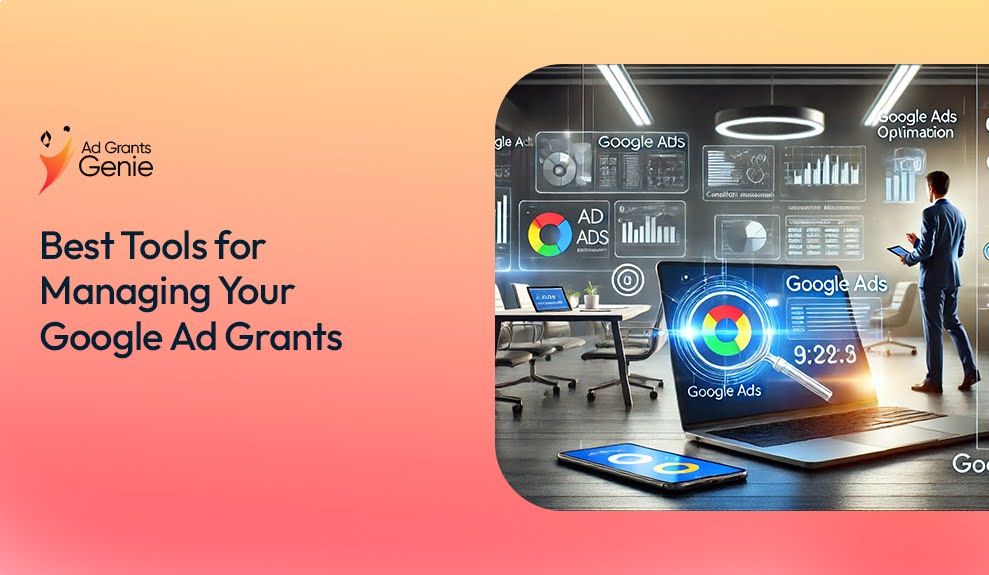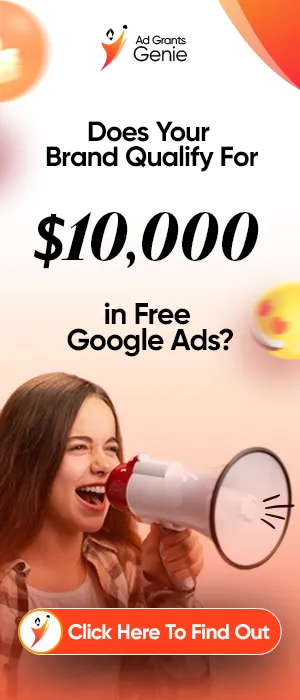Nonprofits using Google Ad Grants have unique opportunities—and challenges. Optimizing every dollar of the $10,000 monthly ad credit is crucial to fulfilling their mission. With the right management tools, nonprofits can streamline processes, optimize performance, and focus on driving impact.
Here’s a comprehensive guide to the best tools for managing Google Ad Grants effectively.
Why Tools Matter in Google Ad Grant Management
Managing Google Ad Grants requires strategic planning and consistent optimization. Since these grants come with certain restrictions, nonprofits need specific tools to track compliance and ad performance effectively. Utilizing the right Ad Grants tools enables organizations to gain insights, manage budgets, and optimize ad performance with ease.
For nonprofits, these tools don’t just save time; they ensure that campaigns remain compliant with Google’s standards. By analyzing which tools best fit their budget and goals, nonprofits can gain a competitive advantage, extending the reach and impact of their campaigns.
The Role of Automation and Efficiency
Automation is essential for efficiently managing Google Ad Grants. Many Google Ads software solutions, such as Optmyzr and SEMrush, offer automated bidding and keyword management that help keep campaigns optimized without extensive manual effort.
When campaigns are optimized through automation, nonprofits can maintain compliance while saving time. From adjusting bids to fine-tuning keyword matches, these automation features free up resources and maximize grant value. With the right tools, automation ensures continuous performance improvements.

Google Ads Interface: A Beginner’s Guide
For newcomers to Google Ads software, the dashboard can seem daunting. Understanding the Google Ads interface is the first step to building effective campaigns.
- How to Navigate the Google Ads Dashboard: Nonprofits should familiarize themselves with key sections like Campaigns, Ad Groups, and Keywords. Understanding the different tabs makes it easier to monitor ad performance and make necessary adjustments.
- Key Features of Google Ads for Nonprofits: Essential features include bid strategies, ad scheduling, and location targeting. Knowing how to adjust these parameters is crucial for maximizing impact.
The Google Ads interface is built with functionality in mind, making it possible to manage multiple campaigns at once and adjust settings based on audience engagement. You can check our blog on some common Google ad grant mistakes.
Google Keyword Planner for Optimized Campaigns
Keyword research is at the heart of any successful ad campaign. The Google Keyword Planner, an invaluable Ad Grants tool, allows nonprofits to find keywords that resonate with their target audience while staying within the grant’s restrictions.
- How to Perform Effective Keyword Research: This tool helps users discover high-impact keywords with low competition and high relevance. Nonprofits can use it to refine their targeting and reach potential donors or volunteers.
- Identifying High-Impact Keywords for Nonprofits: Nonprofits should focus on terms that align with their mission and attract their specific audience. Keyword Planner allows for advanced filtering based on location, language, and demographics.
Using the Google Keyword Planner ensures that ads are seen by the right people, improving both relevance and impact.
Google Analytics: Tracking and Improving Performance
Google Analytics is a critical component of tracking success in Google Ad Grants campaigns. For nonprofits, it provides a view of how users engage with the website after clicking on ads, revealing important insights for optimization.
- Setting Up Google Analytics for Google Ad Grants: Properly setting up Google Analytics is essential for accurately tracking data. Integration with Google Ads allows for seamless data flow and more precise tracking of ad performance.
- Key Metrics to Track in Google Analytics: Nonprofits should monitor metrics such as conversion rate, bounce rate, and session duration. These indicators show which aspects of the campaign are performing well and where improvements are needed.
Tracking results with Google Analytics helps organizations optimize ad strategies for better engagement and higher conversion rates.
Google Tag Manager: A Must-Have for Campaign Optimization
Adding Google Tag Manager to the mix allows nonprofits to manage all tracking codes, also known as “tags,” in one place. This makes it easier to track user behavior, ensuring that nonprofits can gather the insights needed to improve their Google Ad Grants performance.
- What Is Google Tag Manager and Why You Need It: Tag Manager allows nonprofits to track events on their website, such as button clicks or form submissions. This tool provides a full view of how users are engaging.
- How to Set Up and Use Google Tag Manager with Your Campaigns: Setting up tags allows nonprofits to monitor engagement more precisely, helping them understand what’s working.
With Google Tag Manager, nonprofits gain more control over their campaigns, allowing them to make data-driven adjustments. You can explore some of the key benefits of Google Ad Grants here.

Google Data Studio: Visualizing Your Ad Grant Success
Google Data Studio is an advanced reporting tool that helps nonprofits turn raw data into visually engaging reports. This is particularly useful for presenting performance insights to stakeholders, allowing them to see the impact of Google Ad Grants in real time.
- Creating Dashboards to Track Key Performance Indicators: Dashboards enable organizations to track metrics such as conversion rates, CTR, and overall engagement.
- How to Use Data Studio for Reporting: Nonprofits can build custom reports that automatically update, giving an accurate and up-to-date picture of campaign performance.
Using Google Data Studio allows organizations to share results visually, increasing transparency and accountability within their teams.
Optmyzr: Optimizing and Automating Your Google Ad Grants
Optmyzr is a leading management tool that specializes in Google Ad Grants automation, offering powerful features tailored for PPC optimization. With tools for bid management, account auditing, and performance tracking, Optmyzr allows nonprofits to keep campaigns competitive.
- Key Features of Optmyzr for Grant Management: Optmyzr provides automated bidding, keyword management, and A/B testing capabilities that optimize ad performance.
- How Optmyzr Can Help Improve Campaign Performance: Optmyzr’s automated solutions help ensure nonprofits are meeting grant compliance requirements while maximizing campaign impact.
For nonprofits, Optmyzr is a practical tool for maintaining consistent performance with minimal manual effort.
SEMrush and Ahrefs: Tools for Keyword Research and Competitor Analysis
Staying competitive is crucial, and SEMrush and Ahrefs are two of the best PPC tools for finding and analyzing competitor keywords.
- How to Use SEMrush to Find Competitor Keywords: SEMrush offers insights into competitors’ most effective keywords, allowing nonprofits to find gaps and opportunities in their campaigns.
- Conducting Competitor Research with Ahrefs for Nonprofits: Ahrefs’ in-depth analytics give nonprofits a clear view of competitors’ SEO and ad strategies, helping them stay ahead.
- Leveraging SpyFu for Competitive Keyword Insights: SpyFu helps nonprofits identify the exact keywords competitors are using in their campaigns. This tool provides detailed information on keyword performance and ad copy strategies, enabling nonprofits to refine their approach and stay competitive.
Using these Ad Grants tools, nonprofits can tailor their strategy to outperform competitors in the same space.

Hootsuite and Buffer: Managing Your Ads and Social Media Together
Aligning Google Ad Grants campaigns with social media efforts can increase reach and engagement. Hootsuite and Buffer support social media management alongside ad campaigns, creating a cohesive outreach strategy.
- Why Social Media Matters for Your Google Ad Grant Campaigns: Social media can boost the impact of ads by providing a platform for engagement.
- How to Use Hootsuite and Buffer to Coordinate Efforts: By using these tools to manage both ads and social media, nonprofits can amplify their message.
These tools help nonprofits synchronize messaging across platforms, making each interaction with their audience more meaningful.
Choosing the Right Tool for Your Nonprofit’s Needs
Selecting the best software for managing Google Ad Grants is critical. While some tools offer powerful automation and analytics, the right choice depends on the nonprofit’s specific needs and budget.
- How to Evaluate the Best Tools Based on Your Budget and Goals: Smaller nonprofits might find free tools sufficient, while larger organizations may benefit from investing in paid options.
- Free vs. Paid Tools: Which Option Is Right for You? Free tools offer great utility, but paid versions unlock advanced features that enhance campaign impact.
With these best tools for managing Google Ad Grants, nonprofits can elevate their digital advertising game, maximize reach, and create measurable impact.
Ad Grants Genie (AGG) offers expert services to help nonprofits maximize their impact through free Google advertising. They specialize in assisting organizations to secure and manage Google Ad Grants, guiding campaign setup, optimization, and compliance. AGG’s team helps nonprofits unlock the full potential of their $10,000 monthly ad credit, ensuring they reach the right audience while staying within Google’s requirements. With AGG, nonprofits can drive more traffic, increase donations, and extend their mission through effective and free Google advertising.





